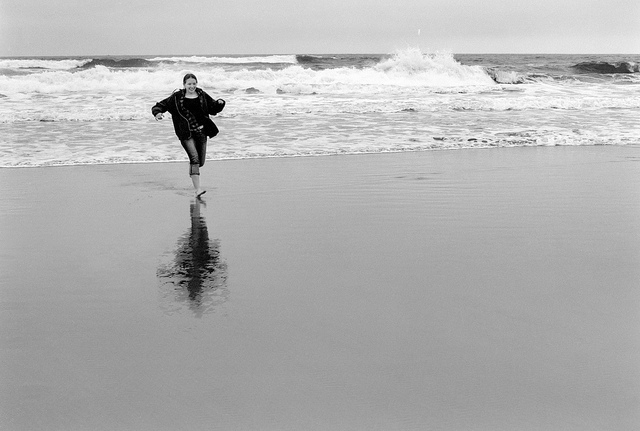Chuck Wendig has written another fantastic article about writing, this time on the subject of
stakes (NSFW -->):
25 Things To Know About Your Story’s Stakes.
Stakes: Making things matter
1. A story's stakes must be clear
The stakes must be clear. What will the protagonist lose if she fails to achieve her goal? What will she gain if she achieves it? Chuck Wendig writes:
"[W]hat is at stake? Life? Love? Money? A precious plot of land? The loyalty of an old friend? A wish? A curse? The whole world? Galaxy? Universe?"
2. Your protagonist's goal must be clear
Protagonists must want things. They can want more than one thing, but they must want one thing desperately and above all else. This thing that is desperately, passionately, wanted is the
story goal. If the protagonist achieves the goal then they've succeeded, if they haven't then they've failed.
For instance, in
Indiana Jones and the Raiders of the Lost Ark, if Indiana finds the ark and brings it back with him then he's succeeded. If not, he's failed.
What are the stakes? If Indie achieves his goal then he gets professional kudos and the opportunity to study a fascinating artifact. If he doesn't achieve his goal then the Nazi war machine will use the ark to help turn the tide of war in their favor.
Of course, the goal can change along the way. In
The Firm Mitch McDeere starts out wanting to be a rich lawyer then, about halfway through the story, his goal changes: he just wants to be free. (He dosen't want either the FBI or the mob to own him.)
3. The stakes must matter to the characters
If the stakes don't matter to the characters ... well, that's like creating a beautiful car but neglecting to put any gas in the engine. If the stakes don't matter to the characters then there's nothing to drive the story.
Chuck Wendig puts it this way: "Why do they care? If they don’t give a damn, why will we?"
4. 'Pinning' the characters to the stakes: making the stakes matter.
A character's
wants,
needs and
fears are what make the stakes matter.
One of my favorite scenes comes from
The Princess Bride. I can't embed it, but here's a link to the (one minute, thirty second) video:
Hello My Name Is Inigo Montoya.
Here, Inigo Montoya takes the life of the man (Count Tyrone Rugen) who killed his father in order to avoid paying him for the sword his father created. It is the story of the injustice done to Inigo's father, Inigo's deep love of his father, his thirst for revenge, his fear that his years of sword training to best the six fingered man will have been in vain ... it is all those things, the messy human stuff, that makes the character--and us!--care about the six fingered man's death, that makes us (okay, me) glory in it.
5. Create conflicts of interest
Chuck Wendig's post is about stakes, but we can't talk about stakes without talking about goals. A story gains depth and texture when the goals of at least two characters are mutually exclusive. The goals of the protagonist and antagonist, for example.
In The Princess Bride this was, I thought, especially well done. In the beginning Inigo Montoya's goal--to kill the man in black (/Westley)--conflicts with Westley's goal to save his one true love. Then, later, Inigo and Westley join forces against Count Rugen and Prince Humperdinck, respectively.
In the end, these shifting alliances give the story a depth, an interest, it would otherwise lack.
As Chuck Wendig writes:
"Every character won’t necessarily gain and lose the same things in a
story. What’s fascinating is when you pit the stakes of one character
against the stakes of another (and one might argue this is exactly what
creates the relationship between a protagonist and an antagonist). A
gain for one is a loss for the other."
6. Stakes: Internal and External
Back to goals.
Characters have internal and external goals.
For instance, in
Shrek the protagonist's internal challenge/conflict was to risk rejection and let people in, to risk rejection and let others know how he
really felt (tell Fiona he loved her) so he could make connections, make friends (with Donkey), and find true love.
Shrek's outer challenge was to rescue Princess Fiona so Lord Farquaad would get all the creatures of fairy out of his swamp.
Different kinds of stakes accompany the different kinds of goals. If Shrek failed to get the creatures out of the swamp, Lord Farquaad would have had Shrek killed. If Shrek failed to lower his defenses and let people in, he would have lost the love of the Princess Fiona and had a sad and lonely existence in his now vacant swamp. A pyrrhic victory.
7. It's not size, it's complexity
It's not the size of the stakes that count, it's their complexity. Chuck Wendig writes:
"It’s all well and good to have some manner of super-mega-uh-oh world-ending stakes on the line — “THE ALPACAPOCALYPSE IS UPON US, AND IF WE DON’T ACT LIKE HEROES WE’LL ALL BE DEAD AND BURIED UNDER THE ALPACA’S BLEATING REIGN” — but stakes mean more to us as the audience when the stakes mean more to the character. It’s not just about offering a mix of personal and impersonal stakes — it’s about braiding the personal stakes into the impersonal ones. The Alpacapocalypse matters because the protagonist’s own daughter is at the heart of the Alpaca Invasion Staging Ground and he must descend into the Deadly Alpaca Urban Zone to rescue her. He’s dealing with the larger conflict in order to address his own personal stakes."
8. Escalate the stakes
Often a protagonist/hero will start off a quest to get something they want, something that will make their life better. Then they find out that it they
don't get it--this thing, whatever it is--not only will their life not be made better (they won't win the million dollars and be able to quit their crappy 9 to 5 job) but it will be made much worse (they'll lose their home and their grandma will have to stay in a nightmare of a retirement community).
By the end of the story they'd be happy just to get back what they had at the beginning and go to their 9 to 5 job and thank their lucky stars they had food to eat, a place to sleep and people to hang out with. Why? Because by the end of the story their world has been turned upside down and it's impossible for things to go back to the way they were.
Generally there's a setback for the hero at the end, a big setback.
This setback could be anything, but let's say it looks as though our protagonist/hero has lost. She's failed to achieve her goal. Not only that, but the stakes--what happens if she does/doesn't achieve her goal--are heightened. Now, not only will our protagonist lose her job and her home, but so will everyone who has helped her on this quest. This, in turn, causes everyone (well, everyone except her mentor who just died a horrible death for standing up to the evil bully) to desert her.
I'm not saying this happens in every story--it doesn't--but the stakes, whatever they are, will escalate. That's part of how one creates dramatic tension/narrative drive.
9. Escalate, complicate, or both
Chuck Wendig writes:
"We can escalate stakes by complicating them and we have at our disposal many ways to cruelly complicate those stakes. A character can complicate the stakes by making bad choices or by making choices with unexpected outcomes (“Yes, you killed the Evil Lord Thrang, but now there’s a power vacuum in the Court of Supervillains that threatens to destroy the Eastern Seaboard you foolish jackanape.”) Or you can complicate the stakes by forcing stakes to oppose one another — if Captain Shinypants saves his true love, he’ll be sacrificing New York City. But if he saves the millions of New York City, he’ll lose the love of his life, Jacinda Shimmyfeather. Competing complicated stakes for characters to make competing complicated choices."
10. Story stakes and scene stakes
Stakes come in different sizes.
You have big stakes--story goal sized stakes--but you can have smaller, micro-sized, scene sized, stakes as well.
For instance, in
Indiana Jones and the Lost Ark, there's a terrific scene in the middle where Indie ducks into a tent to hide from the bad guys and comes across Marion tied up. Indiana is dressed in native garb so, at first Marion doesn't recognize him. Indie (who thought she was dead) begins to untie her then realizes that if the Nazis discover Marion missing they'll know Indie is there looking for the ark. He can't give himself away.
So, what does Indie do? Well, he ties her back up, of course! Marion is furious with him, naturally. It's a great scene.
Lets take a look at the stakes at play. At the beginning of the scene Indie is trying to hide from the guard because he wants the ark.
Indiana's stakes:
Goal: Escape the guards notice and obtain the ark.
- Success: Indiana doesn't get captured and is one step closer to his goal.
- Failure: Indiana is captured, possibly tortured. He fails to obtain the ark and the world is taken over by Nazis.
Marion's stakes:
Goal: Get untied, sneak out of the camp, go to America.
- Success: Freedom.
- Failure: The unknown. She could be tortured, various nasty things could happen to her.
In the middle of the scene the stakes change when Indie realizes he has to tie Marion back up or risk losing the ark.
Indie's goal: To not completely alienate the affections of Miriam.
- Success: Marion's love and gratitude.
- Failure: Her lasting wrath.
For Indie to succeed in winning Marion's affection--or just to avoid making her furious with him--he must help her escape. But he can't. If he does then he risks his primary mission. So he accepts Marion's wrath, ties her back up, and exits the tent.
The point is that mini-goals with their own stakes can pop up within a scene. The scene between Indiana and Marion was especially interesting, I thought, because it highlighted their diametrically opposed interests. Marion would much rather just escape and forget all about the ark, but not Indie.
Chuck Wendig writes:
"Stakes smaller than those able to prop up subplots — let’s call ‘em
“micro-stakes” — can instead be used to support a scene. When entering a
scene, you should ask: “What are the stakes here?” The characters in
any given scene are here in the scene consciously or unconsciously
trying to create a particular outcome for themselves or for the world
around them. Something is on the table to be won or lost... The stakes needn’t be resolved by the end of the scene, and may carry forward to other scenes..."
11. Stakes in dialogue
I hadn't thought about it like this before I read Chuck Wendig's article, but dialogue has goals with stakes attached, or at least it probably should. After all, we communicate for reasons, because we want things. He writes:
"Dialogue in a story is purposeful: it’s conversation held captive and put on display for a reason. Dialogue in this way is frequently like a game, a kind of verbal sparring match
between two or more participants. Again: things to lose, things to
gain. Someone wants information. Or to psyche someone out. Or to convey a
threat. Purpose. Intent. Conflict. Goals."
# # #
Altogether a fantastic article on writing, another in a long line. I'd encourage you to head on over to Chuck Wendig's site and read it for yourself:
25 Things To Know About Your Story’s Stakes.
An Apology
I intended to post this blog yesterday, but, instead, had to move brown cardboard boxes filled with memories.
I'm undergoing that horror known as 'moving'.
Sounds innocuous, doesn't it? But it means I'm neither here nor there. I live at two addresses--the old and the new--but, really, I'm at home at neither because my life has been parceled up into crates and stacked along walls.
As I creep through unfamiliar hallways staring at the brown corrugated reminders of work to come, the boxes begin to seem vaguely challenging. Perhaps threatening.
I think I need to read a Stephen King novel and write a horror story about moving!
Thanks for being patient with me. :)
Cheers, and good writing.
Photo credit: "
Flying Ninja Man" by
Zach Dischner under
Creative Commons Attribution 2.0.











